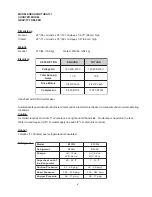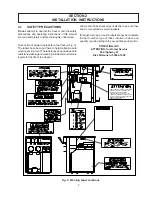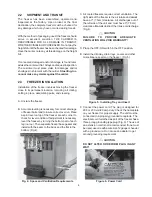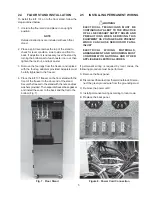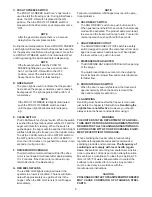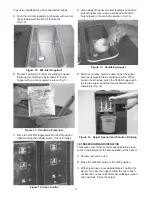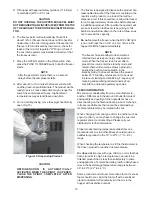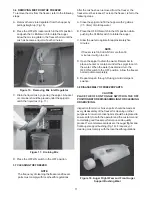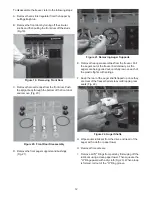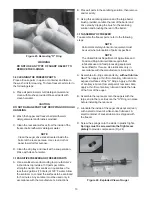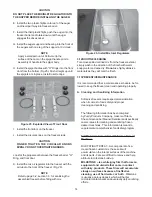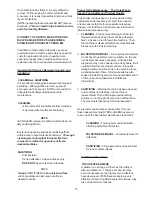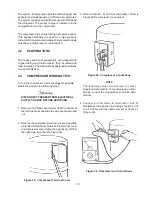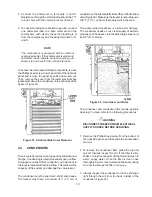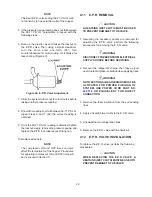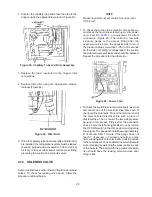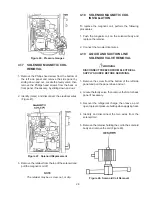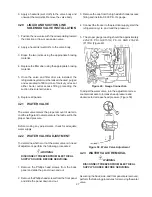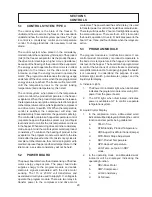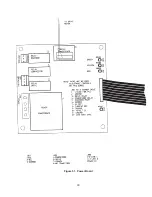
15
Once milkstone has formed, it is very difficult to
remove. Without using the correct product and
procedure, it is nearly impossible to remove a thick
layer of milkstone.
(NOTE: general-purpose cleaners DO NOT remove
milkstone.)
This can lead to high bacteria counts
and a food safety dilemma.
IT IS BEST TO CONTROL MILKSTONE ON A
DAILY BASIS BEFORE IT CAN BECOME A
SIGNIFICANT FOOD SAFETY PROBLEM.
In addition to food safety, milkstone can cause
premature wear to machine parts which can add to
costs for replacement parts or possibly more
expensive repairs if worn machine parts are not
replaced once they have become excessively worn.
Important Differences Between Cleaning and
Sanitizing
CLEANING vs. SANITIZING
It is important to distinguish between cleaning and
sanitizing. Although these terms may sound
synonymous, they are not. BOTH are required for
adequate food safety and proper machine
maintenance.
CLEANING
·
Is the removal of soil materials from a surface.
·
Is a prerequisite for effective sanitizing.
NOTE
An UNCLEAN surface will harbor bacteria that can
defy sanitizing efforts.
Bacteria can develop and resist sanitizing efforts
within a layer of soil material (milkstone).
Thorough
cleaning procedures that involve milkstone
removal are critical for operators of frozen
dessert machines.
SANITIZING
·
Kills bacteria.
·
Can be effective on clean surfaces only.
·
DOES NOT
clean or remove milkstone.
NOTE
Using a
SANTITIZER
on an unclean surface
will not
guarantee a clean and safe frozen
dessert machine.
Proper Daily Maintenance: The Only Way to
Assure Food Safety and Product Quality
Proper daily maintenance can involve a wide variety
of products and procedures. Overall, the products
and procedures fall into three separate categories.
(Please note that this is a brief overview intended for
informational purposes only.)
1.
CLEANING
– This involves draining mix from the
freezer barrel and rinsing the machine with water.
Next, a cleaner is run through the machine. Then,
the machine is disassembled and removable parts
are taken to the sink for cleaning.
2.
MILKSTONE REMOVAL
– Since almost all cleaners
do not have the ability to remove milkstone, the use
of a delimer becomes necessary. Although this
procedure may not be needed on a daily basis, it will
usually follow the cleaning procedure. It requires
letting a delimer solution soak in the machine for an
extended period of time. Individual parts are also
soaked in a deliming solution for an extended period
of time (more about delimers in
Additional
Information
).
3.
SANITIZING
– After the machine has been cleaned
and contains no milkstone, the machine is
reassembled. Then a FDA-approved sanitizing
solution is run through the machine to kill bacteria.
The machine is then ready for food preparation.
As a recommended cleaner and sanitizer for your
frozen dessert machine, STERA-SHEEN has proven
to be one of the best daily maintenance products for:
·
CLEANING
– Thorough removal of all solids
including butterfat and milk fat.
·
MILKSTONE REMOVAL
– Complete removal of
milkstone.
·
SANITIZING
– FDA-approved no rinse sanitizer
for food contact surfaces.
Additional Information
THE USE OF DELIMERS
A delimer is a strong acid that has the ability to
dissolve milkstone. This type of chemical may
become necessary once high levels of milkstone
have developed. While these products are very
effective for removing HIGH levels of milkstone, they
are not ideal for two reasons:
Summary of Contents for E131G
Page 1: ...Model E131G F131G SERVICE MANUAL Manual No 513537 3 Mar 2004...
Page 2: ......
Page 14: ...6...
Page 38: ...30 Figure 51 Power Board...
Page 39: ...31 Figure 52 Program Module...
Page 54: ...46...
Page 66: ...58...
Page 68: ...60...
Page 69: ...61 666786...
Page 70: ...62...
Page 71: ...63...
Page 72: ...64...
Page 73: ...65...
Page 74: ...66...
Page 75: ...67...
Page 76: ...68...
Page 77: ...69...
Page 78: ...70...
Page 80: ......


